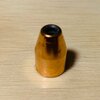Okay, here goes…
First some caveats…you will not be satisfied with my pictures, explanation, nor technique. Most of you won’t. So be it.
First the pictures:



Now that
@GeoDudeFlorida has explained JBWeld, I won’t have to other than to say I’ve been using it and other epoxies for decades (casually, not professionally) and have a “feel” for them—their set up time, etc.
I use only two brands of bullets with this die, Berry’s & Extreme, and only 230gr RN. I had been using a Lee seating dies as shown by
@LiveLife with fine results but wanted the cool looking micrometer of the Redding and its absence of the crimp capability.
But, for some reason, I was getting inconsistent OAL with the Redding and getting marking on the bullets. Maybe I miss diagnosed the problem, maybe not, but I decided all I needed was to have the bullet nose contact the stem, not the ogive.
Using the nose of only two brands of the same bullet meant I didn’t have to be precise as to depth (cue the freaking out & hair pulling).
I read on THR about using hot glue or JBWELD for something similar and a light went off. If I had access to a glue gun that’s what I would’ve used.
Took the die apart and grabbed a dozen bullets and placed them in the stem to see what was going on — eyeballed it & literally guessed about how much JBWeld would be necessary and how much displacement would occur.
Put the die back in the press and used a couple of dummy cartridges and raised the ram to figure out how high it needed to be for the bullet to just enter the stem.
Again, eyeballed it.
Took stem out of die and without a spare or backup plan, I mixed up the JBWeld and used a toothpick to schmear it into the stem. Set it upright overnight I’m guessing and once it had set up sufficiently, dropped it in the die and with a dummy cartridge, raised the ram to the height I had determined and let it sit there for a day maybe. Did not put any lube or release agent on bullet to prevent sticking. Got lucky.
When satisfied, I lowered ram, took stem out of die, and voilà EXACTLY as shown in the picture. No touch up, not sanding, no polishing. It was perfecto.
Sorry class, no micrometers or any other professional equipment or techniques used here…just the imagination of a 70yo tinkerer. And lots of luck!













